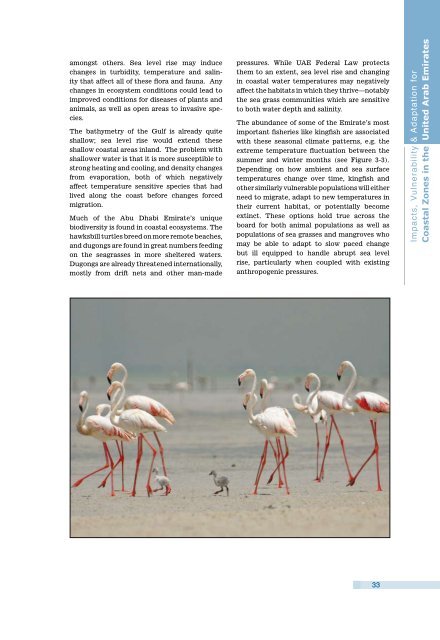climate change on UAE - Stockholm Environment Institute-US Center
climate change on UAE - Stockholm Environment Institute-US Center
climate change on UAE - Stockholm Environment Institute-US Center
Create successful ePaper yourself
Turn your PDF publications into a flip-book with our unique Google optimized e-Paper software.
am<strong>on</strong>gst others. Sea level rise may induce<br />
<str<strong>on</strong>g>change</str<strong>on</strong>g>s in turbidity, temperature and salinity<br />
that affect all of these flora and fauna. Any<br />
<str<strong>on</strong>g>change</str<strong>on</strong>g>s in ecosystem c<strong>on</strong>diti<strong>on</strong>s could lead to<br />
improved c<strong>on</strong>diti<strong>on</strong>s for diseases of plants and<br />
animals, as well as open areas to invasive species.<br />
The bathymetry of the Gulf is already quite<br />
shallow; sea level rise would extend these<br />
shallow coastal areas inland. The problem with<br />
shallower water is that it is more susceptible to<br />
str<strong>on</strong>g heating and cooling, and density <str<strong>on</strong>g>change</str<strong>on</strong>g>s<br />
from evaporati<strong>on</strong>, both of which negatively<br />
affect temperature sensitive species that had<br />
lived al<strong>on</strong>g the coast before <str<strong>on</strong>g>change</str<strong>on</strong>g>s forced<br />
migrati<strong>on</strong>.<br />
Much of the Abu Dhabi Emirate’s unique<br />
biodiversity is found in coastal ecosystems. The<br />
hawksbill turtles breed <strong>on</strong> more remote beaches,<br />
and dug<strong>on</strong>gs are found in great numbers feeding<br />
<strong>on</strong> the seagrasses in more sheltered waters.<br />
Dug<strong>on</strong>gs are already threatened internati<strong>on</strong>ally,<br />
mostly from drift nets and other man-made<br />
pressures. While <strong>UAE</strong> Federal Law protects<br />
them to an extent, sea level rise and changing<br />
in coastal water temperatures may negatively<br />
affect the habitats in which they thrive—notably<br />
the sea grass communities which are sensitive<br />
to both water depth and salinity.<br />
The abundance of some of the Emirate’s most<br />
important fisheries like kingfish are associated<br />
with these seas<strong>on</strong>al <str<strong>on</strong>g>climate</str<strong>on</strong>g> patterns, e.g. the<br />
extreme temperature fluctuati<strong>on</strong> between the<br />
summer and winter m<strong>on</strong>ths (see Figure 3-3).<br />
Depending <strong>on</strong> how ambient and sea surface<br />
temperatures <str<strong>on</strong>g>change</str<strong>on</strong>g> over time, kingfish and<br />
other similarly vulnerable populati<strong>on</strong>s will either<br />
need to migrate, adapt to new temperatures in<br />
their current habitat, or potentially become<br />
extinct. These opti<strong>on</strong>s hold true across the<br />
board for both animal populati<strong>on</strong>s as well as<br />
populati<strong>on</strong>s of sea grasses and mangroves who<br />
may be able to adapt to slow paced <str<strong>on</strong>g>change</str<strong>on</strong>g><br />
but ill equipped to handle abrupt sea level<br />
rise, particularly when coupled with existing<br />
anthropogenic pressures.<br />
Impacts, Vulnerability & Adaptati<strong>on</strong> for<br />
Coastal Z<strong>on</strong>es in the United Arab Emirates<br />
33










